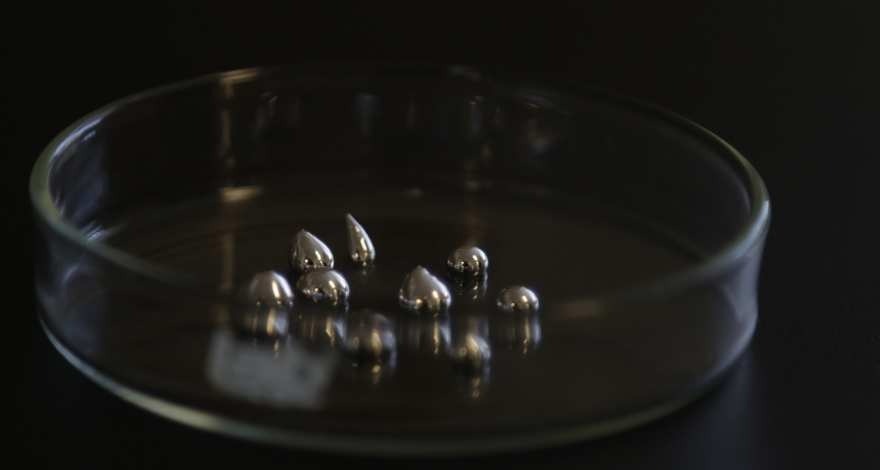By visualizing crystal growth inside dense liquid gallium, researchers uncovered structural details that could boost catalytic performance and clean-energy innovation.
 Study: Observing growth of metallic crystals inside liquid metal solvents. Gallium in a petri dish. Image Credit: Philip Ritchie/The University of Sydney
Study: Observing growth of metallic crystals inside liquid metal solvents. Gallium in a petri dish. Image Credit: Philip Ritchie/The University of Sydney
Researchers at the University of Sydney have successfully synthesized the platinum crystals within a liquid metal medium. This process, facilitated in part by advanced X-ray techniques, has yielded new insights into the nucleation and growth mechanisms of these intricate crystalline structures.
The study was published in Nature Communications.
Beyond their intrinsic scientific interest, these liquid metal-grown crystals hold substantial promise for the development of novel materials. Their potential applications span critical emerging technologies, such as hydrogen extraction from water and innovative quantum computing architectures.
The study, spearheaded by the University of Sydney, demonstrated the application of these metallic crystals in constructing an electrode capable of highly efficient hydrogen generation from aqueous solutions.
Liquid metals, exemplified by Gallium, exhibit unique properties. While presenting a solid-like metallic luster on their surface, they simultaneously possess fluid characteristics.
Gallium, for instance, exists as a solid block at ambient temperatures but transitions to a liquid metallic state upon reaching physiological temperatures.
Witnessing the formation of crystals inside liquid metals like Gallium is a challenging task. Gallium is a very dense element whose atoms are tightly packed and is so opaque it is impossible for most microscopes to pass through a thick layer of Gallium. It was a really special moment to be able to develop a method to do this.
Kourosh Kalantar-Zadeh, Study Lead and Professor, School of Chemical and Biomolecular Engineering, The University of Sydney
The research team utilized X-ray computed tomography (CT), an advanced imaging modality commonly used in medical contexts for the detailed mapping of internal organs.
This advanced imaging technique provided unprecedented 3D visualization of the internal morphology of metallic crystals. Specifically, it captured the dynamic process of crystals emerging within liquid metal, manifesting as distinctive rod-like or frost-like structures that evolved over periods ranging from minutes to hours.
“To see how liquid metals can be harnessed to shape the future of smart materials and identify those that play important roles in energy sources, we need to understand their metallic and chemical properties, inside and out,” said Professor Kalantah-Zader.
With X-ray computed tomography, we can now truly see what we are working with and design liquid metal grown crystals to grow more precisely.
Kourosh Kalantar-Zadeh, Study Lead and Professor, School of Chemical and Biomolecular Engineering, The University of Sydney
The inherent duality of liquid metals, which possess both metallic and fluidic characteristics, renders them highly attractive within the field of materials science. Visionary researchers, such as Professor Kalantar-Zadeh, have long recognized the transformative potential of liquid metals in advancing industrial chemical processes.
The research team is committed to expanding the chemical and technical frontiers of these materials, aiming to develop novel substances and 'green' catalysts that accelerate chemical reactions.
“Liquid metals are also very good solvents, with a powerful ability to dissolve other metallic elements, like sugar in water,” said Professor Kalantah-Zader.
The crystallization of metallic elements occurs when their concentration exceeds the solubility limit, analogous to the supersaturation that leads to sugar crystal formation in aqueous solutions.
For this investigation, platinum beads were dissolved in liquid Gallium or Gallium-indium at 500 °C, and subsequently cooled to induce crystallization.
X-ray computed tomography was then utilized to image a droplet of the platinum-Gallium alloy. Cross-sections were acquired and stitched to reconstruct a 3D image, facilitating the mapping of crystal formation. As the alloy cooled, rapid nucleation of tiny crystal rods was observed.
We observed with fascination how metallic particles of various crystal orientations grew inside liquid metals by changing the temperature and environmental conditions.
Ms. Moonika Widjajana, Study Co-Author and Ph.D. Student, The University of Sydney
Ms. Moonika Widjajana adds, “This study illustrated how X-ray computed tomography can overcome the challenge of observing crystal growth within liquid metal – an opaque material that is usually impossible to penetrate with light and electrons.”
Present technological limits restrict crystal imaging to low resolution; however, advancements in X-ray computed tomography are anticipated to provide higher resolution, improving our understanding of metallic crystal formation.
Journal Reference:
Kang, M., et al. (2025). Observing the growth of metallic crystals inside liquid metal solvents. Nature Communications. DOI: 10.1038/s41467-025-66249-y